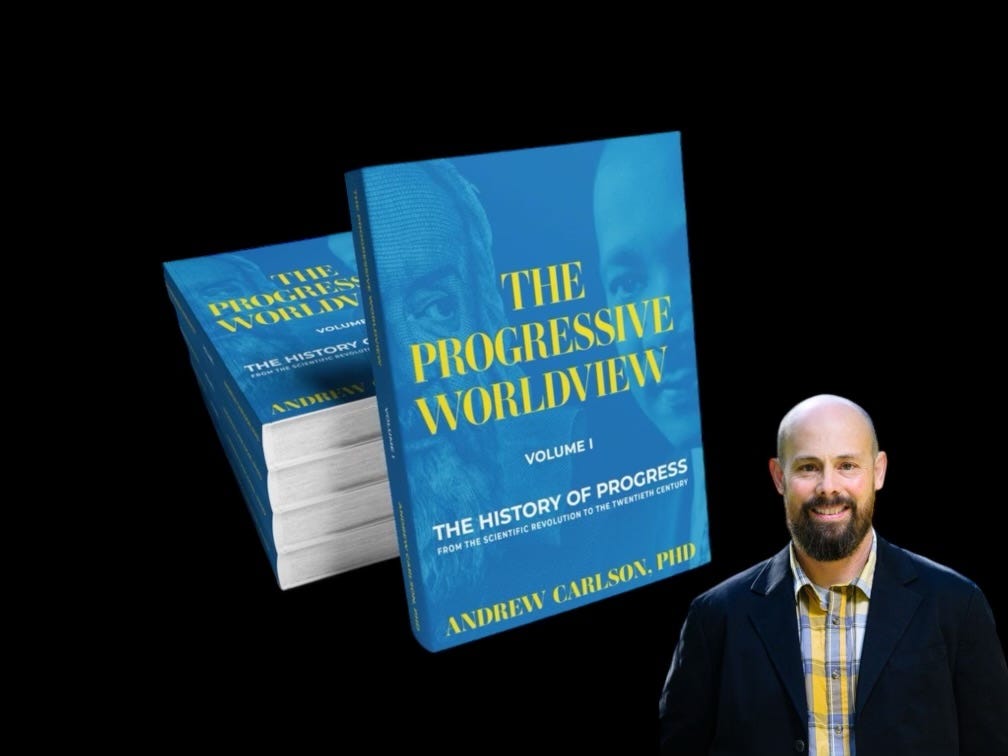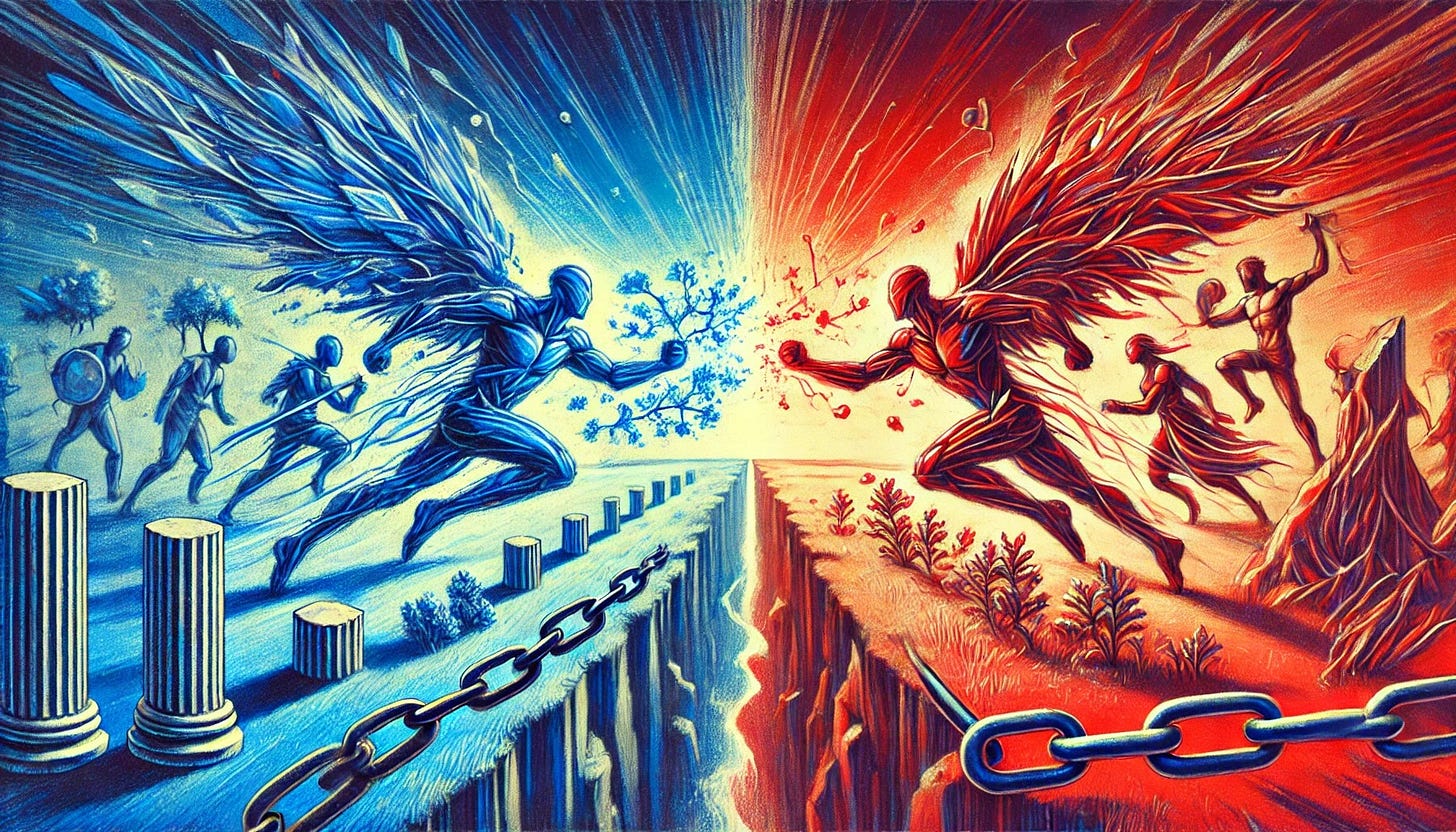The Battle for Human Progress
Unraveling the Philosophical Rift Between Liberal and Conservative Progressives
In his book, “The Progressive Worldview, Volume 1: The History of Progress from the Scientific Revolution to the Twentieth Century,” author Andrew Carlson delves into the complex evolution of the progressive worldview.
By tracing its roots from the Enlightenment to the present, Carlson articulates how the broad spectrum of progressive thought can be categorized into two distinct camps: liberal progressives and conservative progressives.
While both share a commitment to the ideals of the Enlightenment—reason, science, and freedom—their philosophical foundations and visions for the future diverge in significant ways.
Through his examination of these perspectives, Carlson invites readers to reexamine what it means to be a progressive, not only in political terms but as a matter of worldview and philosophy.
His exploration of these ideas helps clarify the ideological rift within progressivism, revealing two distinct paths for how society might best be organized and how progress should be understood.
The Roots of Progress: Enlightenment Thinkers as a Dividing Line
Both liberal and conservative progressives, according to Carlson, can trace their intellectual heritage back to key Enlightenment figures like Thomas Hobbes, John Locke, and Adam Smith. Yet, how each group prioritizes these thinkers reflects their differing visions of what progress entails.
Conservative progressives lean heavily on the insights of Adam Smith and his belief in the free market’s ability to produce optimal societal outcomes. For these thinkers, the invisible hand of the market, when left largely unregulated, allows for competition, innovation, and ultimately, the common good.
Carlson notes that for conservative progressives, progress is achieved by ensuring minimal interference with market forces while maintaining the stability of key democratic institutions.
On the other hand, liberal progressives are more inclined to focus on the role of government, drawing from John Locke’s social contract theory. Carlson explains that for liberal progressives, progress involves using representative democracy to actively shape society.
They view the government as a vital tool for ensuring equity and regulating the market’s excesses. Rather than simply allowing market forces to run their course, they argue that a government should intervene to promote the well-being of all citizens, particularly the most vulnerable.
These differences highlight a fundamental divide in how the two camps view the relationship between individual freedom and collective responsibility. Conservative progressives emphasize the need for limited government to preserve personal liberty and market autonomy, while liberal progressives stress the importance of an engaged government to correct societal imbalances.
The Role of Science: Alignments and Divergences
Both branches of progressivism embrace science as a key driver of human advancement. Carlson underscores that a shared belief in the power of reason and empirical evidence lies at the heart of the progressive worldview. However, when it comes to applying scientific knowledge to governance and societal organization, liberal and conservative progressives diverge.
Liberal progressives have long placed significant emphasis on the social sciences, believing that a deeper understanding of human behavior can lead to better policies and societal structures. Carlson points out that they view human nature as malleable, capable of improvement through education, social programs, and progressive governance.
This aligns with the views of John Dewey, who advocated for education as a means of moral and civic development. For liberal progressives, science is not just a means of understanding the world but also a tool for enhancing human potential.
Conservative progressives, however, approach science with more caution. While they recognize the importance of empirical evidence, they are skeptical of attempts to reshape human nature through social engineering.
Carlson explains that conservative progressives are more likely to align with Hobbes’s view that human nature is fundamentally self-interested and largely immutable. They caution against what they see as an overreliance on social science, or “scientism,” warning that it can lead to overreach and utopian experiments that fail to account for the complexities of human behavior.
In essence, while both camps value science, they differ in how they apply scientific knowledge to human nature and societal progress. Liberal progressives see science as a pathway to moral and social evolution, while conservative progressives emphasize pragmatism and the limitations of what science can achieve in the social realm.
Moral and Ethical Foundations: Hobbes vs. Kant
Carlson identifies another key philosophical fault line between the two camps in their ethical frameworks. For conservative progressives, Hobbes’s view of human nature as self-interested is central.
Hobbes argued that, in a state of nature, humans would be in constant conflict, driven by their desire for self-preservation. The solution to this dilemma lies in creating institutions, such as markets and governments, that channel self-interest into cooperative and peaceful behaviors.
According to Carlson, conservative progressives embrace this view, believing that societal progress involves designing systems that align with humanity’s natural tendencies rather than attempting to change them.
In contrast, liberal progressives look to Immanuel Kant for guidance. Kant believed that while humans are driven by self-interest, they also have the capacity to transcend it through reason and moral duty.
For Kant, progress involves not just managing self-interest but cultivating our capacity for ethical behavior and treating others as moral equals. Carlson notes that liberal progressives are drawn to this vision, seeing the role of government and social institutions as promoting not just order but also justice and equality.
This distinction in moral philosophy leads to differing approaches to policy and governance. Conservative progressives focus on maintaining order and fostering environments where self-interest can lead to beneficial outcomes. Liberal progressives, on the other hand, aim to cultivate moral growth and advance social justice, even if it requires more government intervention.
Visions of the Future: Competing Approaches to Societal Progress
Carlson observes that both liberal and conservative progressives are united in their belief that society can and should improve over time. Yet, their methods and goals diverge, particularly when it comes to the question of whether human nature itself can change.
Liberal progressives, drawing inspiration from Dewey and other reformers, believe in the possibility of moral and intellectual evolution.
Carlson explains that they see education, civic engagement, and progressive policies as tools for creating a more enlightened and cooperative society. For these progressives, progress is a dynamic process that involves constant reflection, adaptation, and reform.
Conservative progressives, informed by the thought of Friedrich Hayek, take a more restrained view. Carlson points out that they are skeptical of grand schemes for social improvement, arguing that attempts to engineer societal change often backfire.
They view human nature as largely fixed and believe that progress is best achieved by preserving the conditions for individual freedom and market competition. For them, societal evolution should occur organically, without heavy-handed interventions from the state.
Toward a Broader Understanding of Progressivism
Carlson concludes that the liberal-conservative divide within progressivism is not simply a matter of political differences but reflects deeper philosophical disagreements about human nature, the role of government, and the nature of progress itself.
Both camps, he notes, share a commitment to Enlightenment values but interpret those values in ways that lead to different policy prescriptions and visions for the future.
By highlighting these distinctions, Carlson challenges readers to think more critically about what it means to be a progressive in the 21st century. Rather than viewing progressivism as a single, unified ideology, he encourages a more nuanced understanding that recognizes the diversity of thought within the progressive tradition.
In doing so, Carlson hopes to foster a broader, more inclusive dialogue among progressives of all stripes. By acknowledging the validity of both perspectives—whether it’s the liberal belief in human potential or the conservative emphasis on pragmatic realism—progressives can engage in a richer conversation about how best to pursue a more just, free, and prosperous society.
In an age of polarization, Carlson’s exploration of these ideas offers a refreshing invitation to curiosity, open-mindedness, and thoughtful reflection on the paths toward a better world.
Since January of 2020, Great Books, Great Minds has provided subscribers community, connection and conversation around books for free—no paywall.
But our future relies on you. At $6.00/month or $60.00 per year, please help me sustain our vision of impacting one million readers worldwide by 2030.
Diamond Michael Scott, Global Book Ambassador and Influencer






